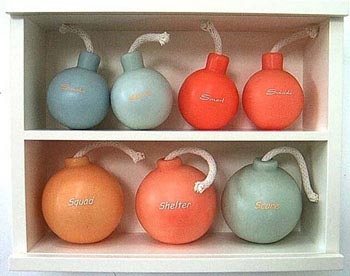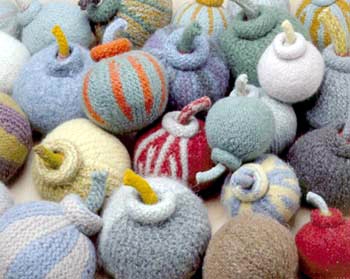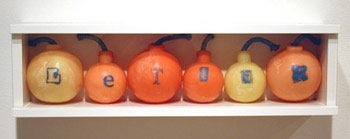Feature: Reviews
Maria Porges
- John Berggruen Gallery
- January 9 - February 8, 2003
Bombast: Return to Dr. Strangelove
A Short History (with Full Disclosure)
In the two decades that I’ve known her and followed her work, Maria Porges’s sculptures have been made from an array of media: salvaged windows, second-hand books, furniture arranged in tableaux, cast wax, glass, and metal objects. Though her forms have changed, time, history, memory, text and narrative have remained as enduring motifs in her work. Over the past decade she’s become well known for her Wunderkammerer-inspired shelves and cabinets containing elegant text-inscribed, cast-wax bottles with narrative content straddling rueful satire and tender compassion. Those pieces, along with the earlier found-object assemblages, revealed Porges as a storyteller with wry insight into human foibles and passions.
Bombs Away
In her recent exhibition of sculpture and Iris prints at John Berggruen Gallery, Porges retained many formal elements from her previous works. However, the familiar colored wax bottles have been replaced with iconic, cartoony bomb shapes, round cannonballs with twisted, nervous-looking rope fuses; and several new pieces have come off the shelf entirely to occupy the open wall. This new work has an edgier, raw feeling, clearly informed by the unease of current events; in a few cases, the vitality and daring of the new pieces is (gratifyingly) reminiscent of her very early, handmade found-object assemblages. Her use of bombs as a recurring motif neatly reflects the paranoia being flogged in the media and promulgated by the administration, and the very real looming prospect of a foreign war. In her recent artist’s statement she cites her concerns for her infant twin daughters as a starting point for this work; another inspiration came from the subtitle of the film Dr. Strangelove (“How I stopped worrying and learned to love the bomb”).
Certainly among the most lovable of her new bombs are those in Bomboozle, a tabletop of small bombs knitted of wool, replete with short fuses. As with previous work, Porges skillfully instills these inanimate objects with anthropomorphic qualities. The roly-poly shapes evoke in equal parts a huddled litter of small, cuddly creatures, warm sweaters hand knit by a grandmother, and stuffed toys from a child’s nursery. Each fuzzy bomb begs to be touched. This separation of signifier from signified confuses - if not defuses - the negative associations of bombs, while the strangely mixed metaphors of violence and innocence brings to mind other stories featured in the past year’s news: gun-toting African boy soldiers and young extremists nurtured from infancy on the fanatic’s dream of dying a hero’s death in a suicide bombing. However, Iris prints of the Bomboozle installation lack the tactility and impact of the actual objects.
Cocktail Hour
Porges’s Molotov Museum I is a wall-mounted grouping of twelve elegant, flat-faced glass bottles, placed in the positions of numbers on a clock dial. The bottles contain a pale orange liquid the color of gasoline, and the bottle necks are stuffed with rags. Each Molotov cocktail is labeled with a vernacular phrase in text, magnified by a lens of glass and fluid. “Hand to hand”, “house to house” and “man to man” evoke images of combat; “coast to coast” suggests high-speed communication, or geographic surveillance; while “heart to heart” and “eye to eye” suggest the possibility of dialog and negotiation while disconcertingly implying dismembered body parts. In the matrix of these Molotov-borne entendres are the intimations of choices and outcomes as the clock continues to tick; this piece exemplifies the engaging linguistic play and narrative possibility that has always been an element of Porges’ work.
I Spy
Spy vs. Spy is a wall-mounted length of snarled metal tubing, each end terminating in a cast bronze “bomb.” The barely contained tension of the coiled tubing makes this piece looks as if ready to snap, flailing, from the wall to wreak havoc. The black and white patinas on the respective bombs are a sly reference to Mad Magazine cartoon characters and their exaggerated assaults on one other. This may be in part Porges’ cautionary tale against taking extreme stances, oversimplifying complex differences into simple black and white. Further, the bombs are inseparable, connected by a single umbilicus, implying that impetuous action by one means the destruction of both.
Paradise Lost
Several of the smaller pieces, like the terra-cotta Dirty Bombs, quite literally made from “dirt” (clay), are more direct, one-line puns. Letter Bomb, a box with a row of wax bombs in cheerful, tropical-fruit colors uses the form of her recent work. Each bomb is embellished with a letter in mismatched typeface, spelling out the word “letter” in the script of a ransom note. Bomb School is more ominous, a shelf of three tinted glass bombs with rope fuses, etched respectively with the words “atom”, “bug” and “cherry.” Inside each glass vessel is a pile of crystalline powder that might be a toxic chemical or could be as innocent as coarse-ground salt. Again, with economy of means Porges taps into our collective paranoia, recalling the revelation of terrorist training camps in Afghanistan and the toxic letter scare that followed. On a deep level, much of this work contemplates innocence and innocence lost; Porges’ A-B-C’s reflect the wide variety of destructive toys and tools that had found their way, unconsidered, into our everyday culture and vernacular, and illustrates how their meaning has shifted in this altered context.
Camouflage
Among the most captivating and challenging pieces in this show is Porges’ Screenplay Dream (The Terrorist’s Disguise). When I first saw it, I read it as a kind of homage to Magritte’s painting L’Homme au Journal (Now You Don’t) (1927), and to his Le Viol (The Rape) (1945), two surreal portraits in which the features on a face were replaced by a female torso, so that breasts substituted for eyes and pubic patches replaced the mouths.
In Porges’ “portrait,” her hand-drawn image of a retro-sixties hairstyle is pinned on the wall behind a metal stand that supports a tall bottle and two smaller connected bottles. The three strategically placed bottles, their necks stuffed with rags liked Porges’ other Molotov cocktails, subliminally recreate the eyes, mouth and nose missing from the empty space framed by the drawn hairstyle. I could see the links back to her much earlier drawings from the early 1980’s, and it was exciting to see her talent as a draughtswoman resurface. I thought of it as an unusual portrait until I remembered a reference in Porges’ statement to a third inspiration for this body of work, her own story about a female terrorist. She had written it and set it aside, but returned to it after the events of 9/11 changed the world in which her twin daughters would grow up. A copy of the short story is available at the front desk of the gallery on request; it is both a useful supplement to the contents of the exhibition and an opportunity to read Porges’ fiction for those who haven’t had that pleasure. Informed by her short story, the retro-hairstyle drawing and Morandi-like arrangement of bottles forming a face take on a different meaning. Yet, I was struck again by the three arranged bottles, whose skirt-like flaring bases and rag plumes resembling flowing hair reminded me of female forms. The two smaller bottles are connected like Siamese twins, and the taller bottle behind them has a maternal, almost protective air. In them, I saw a subliminal portrait of Porges with her twin daughters. These interpretations could be projection on my part, or hidden content by the artist, but the rich layering of sources, meaning and possible readings is one of the ongoing delights of experiencing Porges’ work. For me, the remarkable consistency of her voice within inventive physical variations in fabrication and media continues to make her work compelling and intriguing.



